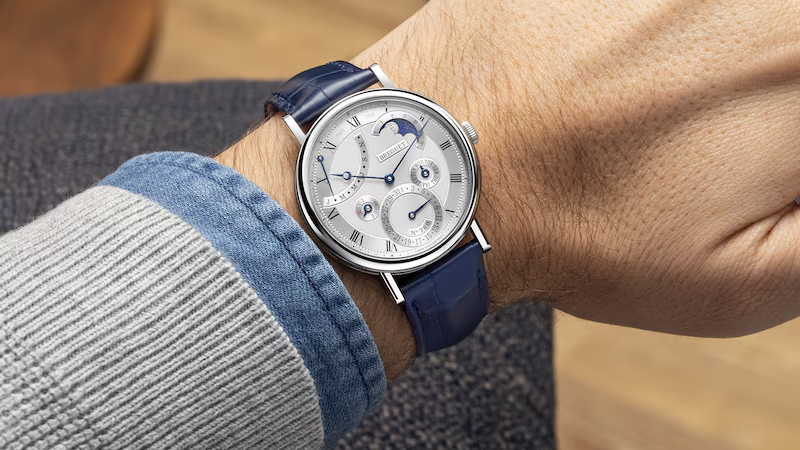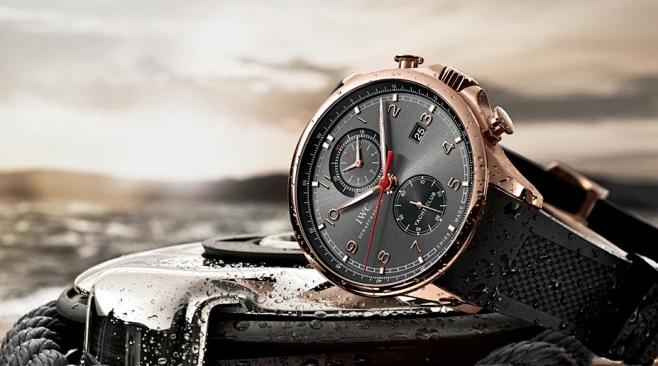Introduction
In the world of luxury horology, few names are as revered as International Watch Company (IWC) and Breguet. Both brands are pillars of Swiss watchmaking, steeped in history and known for their precision, craftsmanship, and engineering excellence. However, despite sharing the same Swiss heritage, IWC and Breguet stand at opposite ends of the technological spectrum in certain ways.
On the one hand, IWC has carved a niche with its focus on engineering advancements, cutting-edge materials, and precision movements that cater to both professional and casual wearers. The brand’s dedication to creating functional timepieces with technological innovations like ceramic cases, perpetual calendars, and automatic chronographs has made it a favorite of those who value performance and versatility.
On the other hand, Breguet, founded by Abraham-Louis Breguet in 1775, is one of the most prestigious names in horology, known for its pioneering complications, fine artistry, and historical significance in watchmaking. Breguet’s technical prowess is expressed in tourbillons, minute repeaters, perpetual calendars, and other intricate complications, which have earned it the title of master of haute horlogerie. The brand’s focus is often as much on aesthetic beauty and heritage as on technological innovation.
But which of these legendary brands stands out in terms of watchmaking technology? How do IWC and Breguet compare when it comes to innovation, mechanical complexity, materials technology, and overall technological advancements in their watches?
In this article, we’ll delve deeply into the technological offerings of IWC and Breguet, comparing the advanced features, complications, and materials that each brand has brought to the table over the years. We’ll examine how these innovations have shaped their reputation in the watch industry and, importantly, how they impact the experience of the end user—the wearer of these fine timepieces.
1. Historical Foundations and Technological Evolution
Before we dive into a detailed comparison of the technological aspects of IWC and Breguet watches, it’s important to understand the origins of each brand and the unique path they’ve followed in terms of technological development.
IWC: A Legacy of Precision Engineering and Innovation
IWC was founded in 1868 by Florentine Ariosto Jones in Schaffhausen, Switzerland. Known for its focus on precision engineering and technical excellence, IWC has made a name for itself by producing military-grade timepieces and aviation watches, as well as dive watches that can withstand extreme conditions. The brand quickly gained a reputation for developing robust, reliable, and innovative movements—a tradition that continues today.
From the outset, IWC has embraced technical innovation. Its early focus was on engineered precision and functionality, which led to the development of their first pocket watches and later, the renowned Pilots Watch and Mark series—instruments designed to meet the demands of aviators. IWC’s bold designs were never just about aesthetics, but about enhancing functionality with new technologies.
Notable milestones in IWC’s technological journey include:
- 1940s: Introduction of the Mark series (Mark XI), designed for military pilots, featuring a caliber 89 movement, which became one of the brand’s defining technological advancements.
- 1980s: The launch of the Portuguese Automatic, a model featuring a self-winding movement.
- 2000s: The development of ceramic cases, offering a lightweight and durable alternative to traditional metals.
- 2015: The release of the Big Pilot’s Watch Perpetual Calendar, a mechanical marvel that integrated advanced complications like a perpetual calendar and moon phase indicator.
Breguet: The Master of Complications and Artistic Technology
Founded in 1775 by Abraham-Louis Breguet, the brand has long been recognized for its innovative mechanisms and pioneering complications. Breguet is credited with several breakthroughs in watchmaking technology, including the invention of the tourbillon (a device that compensates for gravitational errors), the perpetual calendar, and Breguet hands—the iconic moon-shaped hands used in many of their timepieces. In addition to these innovations, Breguet has a long history of creating exquisite timepieces for royalty and nobility—watches that combine functionality with artistic beauty.
Breguet’s contributions to horology are immense, with many of the technologies it introduced laying the foundation for future generations of mechanical watchmaking. The brand is particularly well-known for its complicated movements, including the minute repeater, perpetual calendar, tourbillon, and the chronograph.
Key technological milestones for Breguet include:
- 1795: The invention of the tourbillon, an innovative mechanism designed to improve the accuracy of pocket watches.
- 1827: Introduction of the perpetual calendar, another hallmark of Breguet’s commitment to advancing horological technology.
- 1830s: Creation of Breguet hands and the development of engine-turned dials (guilloché).
- 21st Century: The Classique collection, featuring minute repeaters, tourbillons, and other complex movements, is a showcase of the brand’s dedication to technological brilliance.
2. Technology Comparison: Movements, Complications, and Innovations
At the heart of every high-end watch lies the movement—the intricate mechanism that powers the timekeeping and complications. Both IWC and Breguet are known for developing in-house movements and embracing new technologies that set them apart in the world of luxury horology. But how do these two brands compare in terms of movement technology?
IWC Movements: Precision and Performance
IWC is known for its robust, precise movements that combine technical innovation with sophisticated engineering. The brand has long been a pioneer in mechanical watches, creating movements that excel in performance and reliability. Some of the key features that stand out in IWC’s movements are:
- Engineering Excellence: IWC is renowned for its self-winding movements and chronograph calibers. The brand often incorporates dual spring barrels and power reserve mechanisms into its designs to ensure extended functionality and long-lasting accuracy. The IWC 52010 caliber, for example, features a seven-day power reserve, making it ideal for long periods between winding.
- Ceramic Cases: IWC’s introduction of ceramic materials has significantly improved the durability and weight of its timepieces. Ceramic cases are resistant to scratching and corrosion, providing increased longevity while maintaining a light, comfortable feel on the wrist.
- Perpetual Calendar: IWC has brought its engineering ingenuity to the perpetual calendar complication, most notably in models like the Big Pilot’s Watch Perpetual Calendar. These movements are capable of automatically adjusting for leap years, months, and days, ensuring accuracy without manual correction.
- Pilot’s Watches: IWC’s Pilot’s Watches are equipped with advanced functionality, such as UTC (Coordinated Universal Time) adjustments and GMT complications, making them suitable for professional aviators.
Breguet Movements: Haute Horlogerie at Its Finest
While IWC focuses on engineering efficiency and performance, Breguet has earned its reputation for the intricate beauty and complexity of its mechanical movements. The brand is synonymous with complicated timepieces, many of which represent the pinnacle of haute horlogerie. Some of Breguet’s most remarkable technological innovations include:
- Tourbillon: One of Breguet’s most celebrated achievements is the invention of the tourbillon in 1795. This device was designed to counteract the effects of gravity on the escapement of pocket watches, improving timekeeping accuracy. Breguet has since incorporated the tourbillon into many of its most prestigious collections, including the Classique Tourbillon and the Tradition Tourbillon.
- Minute Repeater: Breguet has made significant contributions to the development of the minute repeater, a complication that chimes the time upon request. The brand’s Classique 5327 is an example of a highly complicated timepiece with a minute repeater and tourbillon, reflecting Breguet’s mastery of combining several sophisticated complications into a single timepiece.
- Perpetual Calendar and Other Complications: Similar to IWC, Breguet has also embraced the perpetual calendar complication, often paired with a moonphase indicator. These timepieces are designed to provide maximum accuracy, with adjustments made for leap years and variable month lengths.
- Guilloché Dials: Breguet’s signature guilloché dials are another hallmark of its craftsmanship, combining aesthetic beauty with technological precision. The intricate, engine-turned patterns found on Breguet dials are not only visually stunning but also serve a functional purpose in increasing the watch’s aesthetic depth and legibility.

3. Material Innovation: IWC vs. Breguet
The materials used in the construction of a luxury watch have a significant impact on its performance, durability, and aesthetic appeal. Both IWC and Breguet have embraced material innovations that set their watches apart in terms of both functionality and luxury.
IWC’s Use of Materials: High-Tech Engineering
IWC is known for its functional approach to materials. The brand employs a variety of advanced materials to ensure strength, lightweight construction, and long-term durability:
- Ceramic: IWC’s use of ceramic cases in collections like the Aquatimer and Big Pilot provides a scratch-resistant, lightweight alternative to traditional metals. Ceramic is incredibly strong, yet lightweight, offering an ideal solution for high-performance watches.
- Titanium: IWC uses titanium in many of its models to provide an extremely lightweight yet durable material that is resistant to corrosion and hypoallergenic.
- Stainless Steel: Stainless steel is a staple in IWC’s collection, particularly for its Pilot’s Watches, where the use of high-quality steel offers both strength and polished finishes.
Breguet’s Materials: Elegance Meets Tradition
Breguet, on the other hand, emphasizes luxury and refinement in its materials. The brand’s use of precious metals, enamel dials, and sapphire crystals enhances the aesthetic beauty of its timepieces while maintaining functionality:
- Gold and Platinum: Breguet’s case materials are often crafted from precious metals like 18K gold and platinum, adding an element of luxury to the watch’s presence. These materials are often chosen for their timeless appeal and ability to retain their value over time.
- Enamel Dials: Many Breguet watches feature grand feu enamel dials, which require a delicate process of handcrafting and multiple firings. These dials are often admired for their depth, color, and long-lasting appeal.
- Sapphire Crystals: Breguet also uses sapphire crystals for crystal cases and exhibition backs, offering scratch resistance and enhanced visibility of the movement.
4. User Experience and Technological Impact
Both IWC and Breguet strive to create luxury watches that not only look beautiful but also provide outstanding performance. User reviews often highlight different aspects of each brand’s approach to technology:
- IWC users tend to appreciate the durability, robustness, and reliability of their watches, especially when it comes to high-performance models like the Pilot’s Watch and Aquatimer series. They value the ease of maintenance and the practicality of IWC’s technologies, particularly when it comes to automatic movements and power reserve mechanisms.
- Breguet users, meanwhile, celebrate the brand’s intricate craftsmanship, artistic beauty, and complex movements. They are often drawn to Breguet for its rich horological history and sophisticated complications, even though some users find that maintenance costs and complex movements can require more attention over time.
Conclusion
Both IWC and Breguet are leaders in the world of luxury watchmaking, but their approaches to technology and innovation are distinct. IWC emphasizes precision engineering, functional design, and performance, creating timepieces that excel in real-world applications. In contrast, Breguet stands at the forefront of complicated horology, blending technical mastery with aesthetic refinement to create truly luxurious and complex timepieces.
Which brand leads in watchmaking technology depends on the perspective of the wearer. For those who value durability, reliability, and high-tech engineering, IWC might be the clear choice. However, for collectors and connoisseurs who appreciate artistic craftsmanship, complicated movements, and historical prestige, Breguet reigns supreme.
In the end, both brands offer exceptional levels of technological innovation and craftsmanship, and choosing between them comes down to individual preferences in terms of both performance and style.





































